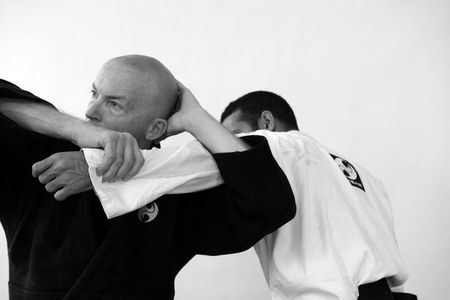Te Makura - The Pillow Hand Technique
Te Makura (手枕, טה מקורה), literally meaning 'pillow hand' in Japanese, is a sophisticated elbow arm lock found in traditional Ninjutsu. This technique combines a sacrifice throw with precise joint manipulation, using the defender's body weight as leverage against the opponent's arm. The distinctive name comes from the way the practitioner's arm wraps around the opponent's limb and then supports the back of their own head like a pillow during execution.
Contents
Historical Background
Te Makura appears in several traditional Japanese martial systems, particularly within the Takagi Yoshin Ryu and Kukishinden Ryu lineages that contribute to modern Bujinkan Ninjutsu. The technique exemplifies the efficient use of body mechanics and leverage that characterizes many classical Japanese joint manipulation methods. While not as commonly known as some other joint locks, Te Makura represents an important tactical option in the comprehensive arsenal of Ninjutsu's control techniques.
Mechanical Principles
Te Makura functions through several key mechanical principles:
- Elbow Hyperextension: The technique creates pressure against the natural range of motion of the elbow joint.
- Leverage Amplification: By using the entire body weight during the sacrifice fall, the practitioner multiplies the force applied to the joint.
- Control Through Alignment: The arm is positioned parallel to the ground to maximize control and minimize the opponent's ability to resist.
- Structural Integrity: The defender maintains their own structural integrity by connecting their arm to their head, creating a strong, unified control position.
Video of Te makura
This demonstration shows the proper execution of Te Makura, highlighting the initial arm control, the transition to the "pillow hand" position, and the controlled fall that completes the technique.
Description of Te makura
The execution of Te Makura follows these key steps:
- Initial Control: The defender secures the opponent's arm and pulls it forward, straightening it at the elbow.
- Arm Positioning: The defender positions the opponent's arm parallel to the ground, extending it directly in front of the face.
- Wrapping Technique: The defender wraps their arm around the opponent's extended limb, creating the initial control.
- Securing the Lock: To strengthen the grip, the defender reaches behind their own head with the same arm that's wrapped around the opponent's limb, creating the characteristic "pillow" position.
- Sacrifice Movement: With the lock secured, the defender falls backward to the ground, using body weight to create significant pressure on the opponent's elbow joint.
- Ground Control: Upon landing, the defender maintains control of the opponent's arm, potentially transitioning to follow-up techniques if necessary.
This controlled descent creates a powerful mechanical advantage that can effectively neutralize even a physically stronger opponent by exploiting the vulnerability of the elbow joint.
Image of te Makura

The image above shows the final position of Te Makura, with the defender on their back and the opponent's arm secured in the lock. Note the characteristic "pillow" position of the defender's arm behind their head, which gives the technique its name and provides the mechanical advantage necessary for control.
Technical Variations
Several variations of Te Makura exist within the Ninjutsu curriculum:
- Standing Application: A modified version that can be applied without the sacrifice fall, useful in scenarios where going to the ground is not tactically advantageous.
- Transitional Te Makura: Used as a transitional technique to flow into other ground control positions or submissions.
- Counter-attack Variation: Applied as a counter to an opponent's striking attack, capturing the arm during or immediately after the strike.
- Weapon Defense Application: Adapted specifically for controlling an armed opponent by securing the weapon-bearing arm.
Applications and Scenarios
Te Makura is particularly effective in the following situations:
- Self-defense Scenarios: The technique provides immediate control against an aggressive attacker and creates distance through the takedown.
- Multiple Opponent Situations: The sacrifice fall can create space from additional attackers while maintaining control of one opponent.
- Weapon Disarmament: When an opponent is armed, Te Makura can facilitate weapon control and potential disarmament.
- Transitional Control: As a bridge between standing techniques and ground control, Te Makura offers tactical flexibility in dynamic encounters.
Training Considerations
When practicing Te Makura, special attention should be given to:
- Partner Safety: The elbow joint is vulnerable to injury, so application pressure should be carefully controlled during practice.
- Falling Technique: The defender must develop proper ukemi (falling skills) to execute the sacrifice movement safely.
- Grip Development: The specific hand position requires practice to achieve the necessary security without relying on excessive strength.
- Timing Refinement: Effective application depends on precise timing, particularly during the transition from standing to the sacrifice position.
Ninjutsu lessons with Te makura
Meta perspectives
This technique incorporates these attributes of Meta Perspectives:
- Intermediate level of expertise - While the mechanical concept is straightforward, effective application requires significant practice to develop the necessary coordination, timing, and control.
- Low level of violence - In training contexts with controlled application, Te Makura can be practiced with minimal risk of injury.
- Medium level of violence - When applied with greater commitment in self-defense scenarios, the technique creates significant control and potential joint stress.
- High level of violence - With full application force, Te Makura can cause severe joint damage and effectively neutralize an attacker.
Related Techniques
Te Makura shares mechanical principles with several other techniques in the Ninjutsu curriculum:
- Hiji Kudaki - Another elbow breaking technique with different entry mechanics
- Ude Gatame - A standing arm bar that targets similar joint mechanics
- Waki Gatame - An armpit arm lock that uses comparable control principles
- Juji Gatame - A cross-body armbar that can function as a follow-up from Te Makura ground position
Understanding these related techniques expands the practitioner's technical repertoire and provides alternative options depending on how the encounter develops.
